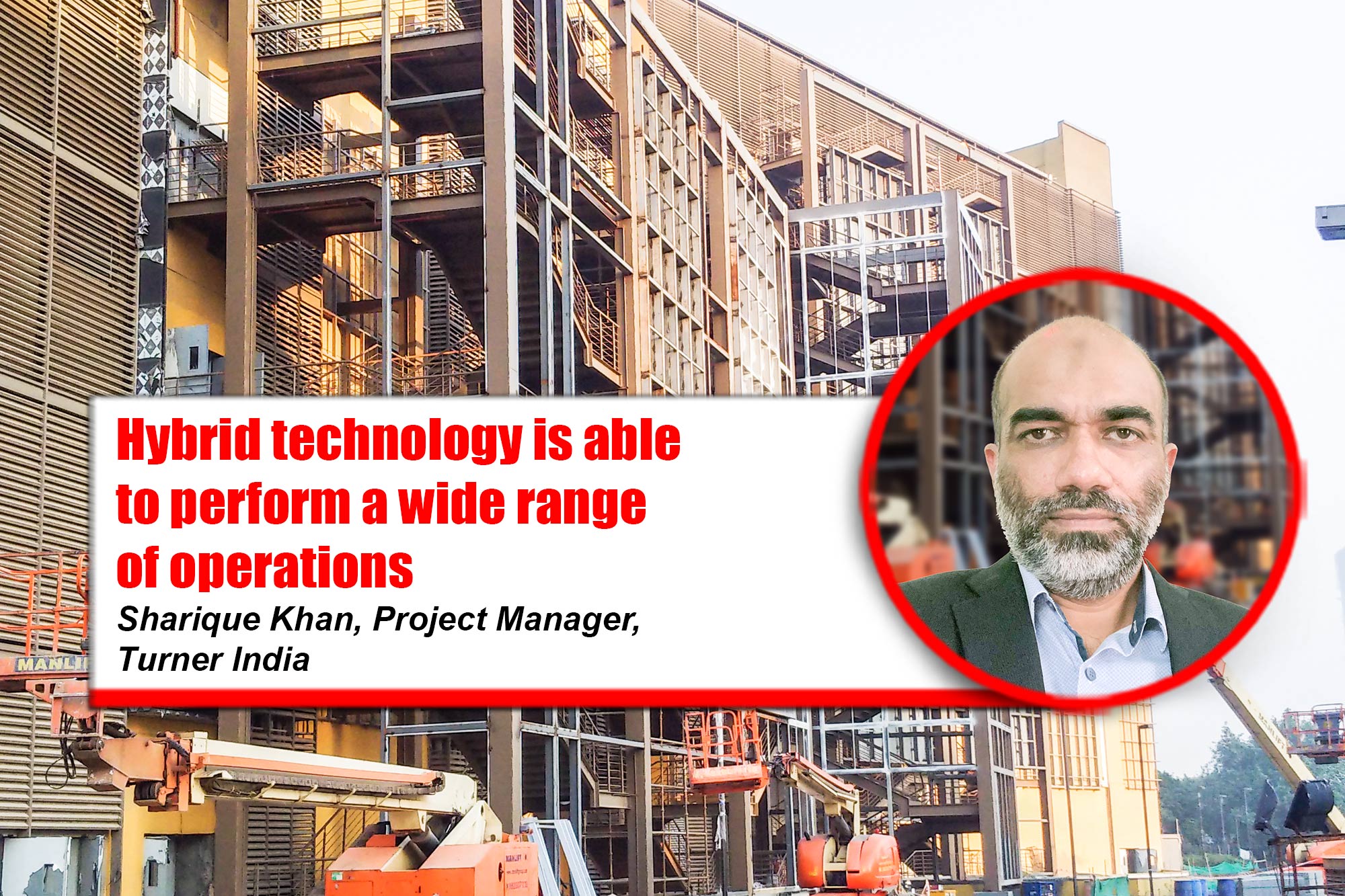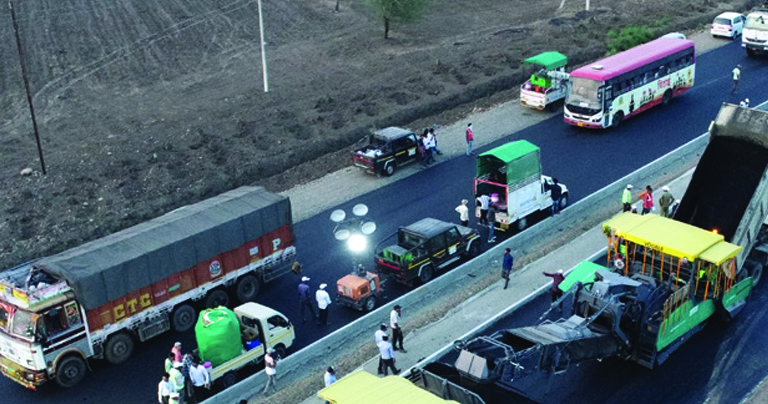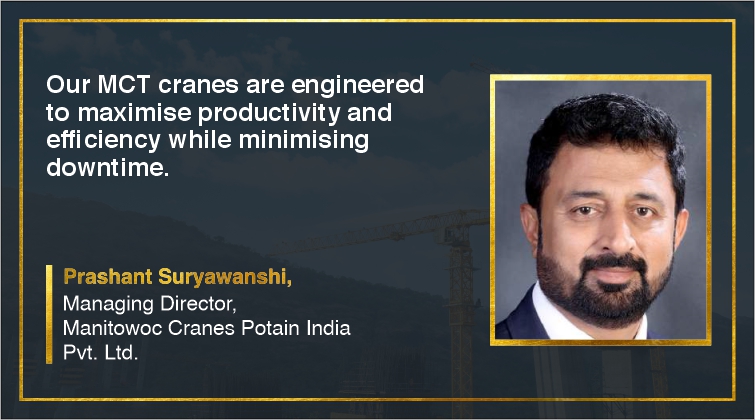Hybrid technology is able to perform a wide range of operations
By Edit Team | July 10, 2020 7:45 am SHARE

Hybrid technology is used to reference any equipment type that has two power sources, or equipment that can collect, store and reuse energy says Sharique Khan, Project Manager, Turner India.
Despite the pandemic, the government has put the vital construction projects on priority wherever possible, how positively will such measures impact the Indian economy?
Growth has taken a hit due to Covid-19 lockdown. It is now imperative that the economy receives an immediate boost in the right direction with timely decisions to generate widespread employment on priority.
Government has promptly reopened some of the construction activities across the country, outside of the containment zones. It was important to hold migrant laborers and provide them employment opportunities in their existing locations. The construction industry is the biggest employer for migrant workers in India, and their absence in the urban construction sites has adversely impacted this sector. Having said that, we have observed an encouraging trend as the laborers have started returning to the cities and resume work on construction projects. Most of the construction projects are now observing an increase in numbers, thereby helping projects to restart.
Supply chain has slowly started building up, and material stuck in transit are getting delivered to project sites. Most of the factories have started operations and returning to the normal production cycle. In spite of air freight slowdown, some of the overseas materials are also getting delivered and suppliers have started giving shipment dates.
The priority of the government is to focus on sectors that will contribute to an immediate and sustainable GDP growth. Allowing the construction sector to restart will immediately put money in the hands of workers; this will also revive the material market and the machinery use. Steel, stainless steel, cement, sand, and transport and logistics industries will also get a significant push. Cash inflow and fund disbursement will trigger demand for fast-moving consumer goods (FMCG), essential commodities etc. and thus have a ripple effect on the economy and help bring it back on track.
As part of Construction Management, what are some of the safety measures you feel need to be adhered to in order to prevent/reduce air pollution due to construction and/or demolition activities?
Air pollution is an issue that the construction industry cannot ignore. Poor air quality is a global health hazard and contributes significantly to global warming. Over the last few years, we have seen the levels of air pollution in the Delhi NCR region turn severe during November and December, due to which a ban was imposed on construction activities in the area causing delays in several projects’ completion.
As construction activities contribute significantly to air pollution, organizations in the sector have a shared responsibility to limit air pollutions on projects. Enforcing pollution prevention strategies can have a significant positive impact on our businesses and sustainably initiatives. The following are some construction management practices that must be adhered to for reducing air pollution on construction projects.
- Conduct risk assessment for all the construction activities and materials likely to cause air pollution.
- Prepare a mitigation/corrective measures plan to reduce air pollution and ensure its implementation.
- Use water sprays or sprinklers to control dust and stop it from spreading while performing activities that may produce dust.
- Moisten the ground at construction site to allow the dust to settle and stop it from spreading.
- Cover the construction material at site (i.e. Cement, sand, etc.)
- The vehicles carrying dust creating material should be properly covered.
- Use Zero VOC and non-toxic paints.
- Atomized misting canons and other wet methods are an effective way to suppress silica and other forms of dust.
- Use on-tool extraction to control dust while performing tasks. This is a type of exhaust that fits onto some tools and removes dust as it is being produced.
- Use ultra/low Sulphur diesel to power equipment and vehicles.
- Improve existing equipment by using particulate filters and catalyst converters.
- Adopt hybrid technology in place of diggers and excavators with diesel engines. For example, use hybrid excavator that runs on electric power.
- Source materials locally to avoid long distance/international transportation.
- Avoid burning any waste materials; it causes smoke and releases poisonous gases such as carbon monoxide into the atmosphere.
In the vital projects what kind of access equipment are needed for the hour to ensure a seamless and on time execution of the task at hand?
Timely project completion is one of key aspects of the construction discipline and efficiency plays an important role in achieving schedule. Every task has two components: value added tasks and non-value added tasks. We have to minimize the non-value added tasks to achieve efficiency and increase productivity. Access equipment plays a pivotal role in minimizing the non-value added tasks assigned with an activity.
Scaffolding was required as part of the traditional way of starting an activity. The time spent in assembling, climbing up while carrying tools/materials, navigating around and moving scaffolds along with the activity were major concerns for achieving efficiency.
With the availability of the right type of access equipment, greater efficiency and productivity can be achieved. To complete MEP and finishes activity in crucial projects, use of MEPWs equipment is necessary (i.e. scissor lift/vertical lifts, boom lifts, etc.).
Scissor/vertical lifts can move easily from one location to another without any complications, reduce the physical effort/exhaustion of the workers and save time immediately. Some scissor lifts are also designed to move few feet horizontally.
Boom lifts have two types: articulated booms and telescopic booms, and these are preferred in areas that are hard to reach because of its long arm that can be angled in various directions.
As per OSHA (Occupational safety and health administration) for the construction industry, falls are one of the most common workplace hazards. As such, MEPWs provide guardrail system and lanyard attachment which are meant to support fall protection. Safety is another major reason to consider MEWPs on vital projects.
What kind of additional on-site safety protocols are you adhering to ensure your workforce too remains safe and sound?
We have developed post Covid-19 SOPs based on the government/WHO/CDC guidelines to be followed in our projects. Our staff is ensuring adherence to the on-site safety protocols mentioned in SOPs, the highlights of which are listed below.
- Monitoring and recording body temperature of all workers entering project site.
- Vehicles are getting sanitized while entering into project premises.
- Regular health surveillance of workers staying at labor camps.
- Contactless hand washing and sanitization station has been provided at multiple locations.
- Multilingual awareness signage boards have been displayed across project.
- Tool box talks are conducted for COVID-19 awareness/precautions while maintaining social distancing.
- Regular disinfection of work areas and site offices.
- Maintaining social distancing while at project office or site.
- Face masks/cover made compulsory for all workers.
- Workers with symptoms are advised to stay at home and seek medical consultation.
- Workers with any symptoms/behavior must report to site clinic and consult the CMO or the Doctor.
- Strict observation of hygiene and sanitation practices.
- Roster has been developed and followed to avoid gathering in office premises.
- Work from home has been assigned, wherever possible.
- Meetings are conducted using virtual platforms.
- Paperless documentation process is being encouraged.
- Conducting factory acceptance test (FAT) using virtual platforms.
- Aarogya Setu App is compulsory for all workers.
We have also developed innovative ways to maintain and follow government guidelines during this pandemic situation. On one of our projects, we have implemented proximity sensor to monitor social distancing for our staffs.
How do you think the supply chain should be managed in this current period effectively termed as Unlock 1.0?
During the COVID-19 pandemic, global supply chain and the global factory model exporting highly specialized products around the world have been disrupted. Construction material segments facing significant impact include metal products, electrical and electronics, mechanical equipment and components, and solar panels among others.
Currently, factories are not running in their full capacities due to social distancing norms. Besides, there is shortage of laborers and raw material. Additionally, the entire supply chain has been affected due to overseas and domestic freight slowdown.
Almost all force majeure clauses only call for extension of time. During this difficult scenario, all parties need to share the burden and show reasonable efforts to help each other continue to perform.
Listed below are a few good practices to manage construction projects’ supply chain in the present scenario:
- Pre-planning is crucial, now more than ever.
- Re-visit schedule, sequence and prioritize activity based on the critical paths.
- Prepare a material list with the required on-job date.
- Wherever possible, consider proactive procurement and build in float for critical/long lead materials.
- Prioritize list items for shipping, and discuss shipping methods.
- Work with all downstream parties to understand your end to end vulnerabilities in the supply chain.
- Begin with focus on material from international/domestic locations and work way down.
- This is a time to be fully transparent and discuss potential scenario openly.
- Do regular communication with suppliers for production and transportation.
- Document, record, and communicate all the delays and deliveries with the stakeholders.
Start working on a Plan B, prepare a risk register assessment, assess if alternate suppliers be engaged, evaluate the cost exposure (escalation potential), and strengthen the supply chain weak links. Start working on building resilient supply chain for future. Frequent disruptions in supply chain are expected and hence, it is important to be prepared with a more collaborative and transparent approach. One must avoid reliance on single sources where possible. Where risks can’t be avoided, it is crucial to identify and manage them. Become a learning organization and grow.
What is your opinion on the hybrid technology which has been an ongoing trend in the access equipment segment? What sort of advantage do they offer?
Hybrid technology is used to reference any equipment type that has two power sources, or equipment that can collect, store and reuse energy. The technology allows manufacturers to use smaller, more efficient engines to achieve fuel savings. Green energy solutions are attaining a whole new level of importance.
Due to the government initiatives to reduce CO2 emissions to control air and noise pollution, there is an increasing pressure on the government bodies to improve local air quality and reduce noise pollution. This will substantially lead to more stringent workplace regulations, and we may see a restriction on the use of diesel-driven machines. Hybrid technology today, are able to perform a wide range of indoor and outdoor applications. A bi-energy hybrid model is the machine that decides itself when the generator is needed. This simplifies operation and can improve battery life. With this innovative hybrid power, battery autonomy is extended by reducing wasted energy, using technologies such as regenerative braking etc.
Operators can work in electric mode for longer shifts, without the need for a plug-in charge. When the machine is operated in hybrid mode, the diesel engine automatically takes over from the battery when the level of charge declines, driving the hydraulic pump directly and recharging the batteries.
Last but not least, the hybrid system continuously maintains the battery level of charge while the machine is in operation to offer a good fuel economy. Some hybrid models save an average of 10-40 % fuel consumption and reduce considerable amount of emissions.
As regulations are becoming stricter and manufacturers will comply with government standards, industry experts believe that the stricter regulations will result in more advanced hybrid technology and more fuel-efficient engines with cleaner-run, off-road engines. It is also expected that end users will look to purchase hybrid equipment in order to cut fuel costs and meet clean air standards as per government guidelines.
Cookie Consent
We use cookies to personalize your experience. By continuing to visit this website you agree to our Terms & Conditions, Privacy Policy and Cookie Policy.





















































